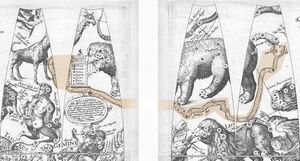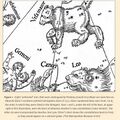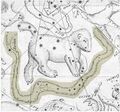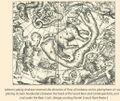Jordanus: Difference between revisions
(small corrections) |
(free => external) |
||
| Line 23: | Line 23: | ||
=== Transformation of Constellation === |
=== Transformation of Constellation === |
||
<gallery> |
<gallery> |
||
File:PreJordanus in Duerer Ian hi.JPG|The eight |
File:PreJordanus in Duerer Ian hi.JPG|The eight 'external' stars south of Ursa Major in Dürer's star chart 1515, described by [http://www.ianridpath.com/startales/ptolemy-spare.html Ian Ridpath] (highlighted by SMH). |
||
File:KEE Jordanus piece hi.JPG|Globe gores of the 1612 celestial globe by van den Keere & Plancius on which Plancius introduced his last set of biblically inspired constellations, including Jordanus (highlighted). |
File:KEE Jordanus piece hi.JPG|Globe gores of the 1612 celestial globe by van den Keere & Plancius on which Plancius introduced his last set of biblically inspired constellations, including Jordanus (highlighted). |
||
File:Jordanus Habrecht hi.JPG|Jordanus constellation (highlighted) in [https://echo.mpiwg-berlin.mpg.de/ECHOdocuView?url=/mpiwg/online/permanent/library/27CWZ8E0&start=351&viewMode=images&pn=356&ww=0.25&wh=0.2654&wx=0.4614&wy=0.4032 Habrecht, Isaak, Planiglobium coeleste ac terrestre (1666)]. |
File:Jordanus Habrecht hi.JPG|Jordanus constellation (highlighted) in [https://echo.mpiwg-berlin.mpg.de/ECHOdocuView?url=/mpiwg/online/permanent/library/27CWZ8E0&start=351&viewMode=images&pn=356&ww=0.25&wh=0.2654&wx=0.4614&wy=0.4032 Habrecht, Isaak, Planiglobium coeleste ac terrestre (1666)]. |
||
Revision as of 13:59, 12 September 2024

An obsolete Early Modern constellation made from eight unnamed Ptolemaic stars: Alpha and Beta CVn, Alpha, 31 and 38 Lyncis (according to Toomer), and three fainter stars of uncertain identity.
Etymology and History
It is the name of a (real) river with immense cultural significance, not only as a border between countries but also for several religions. The English word is a Latin loanword, derived from Semitic 'Yard|on' 'flow down' <√ירד reflecting the river's declivity (Arabic: نَهْر الْأُرْدُنّ, Nahr al-ʾUrdunn, Hebrew: נְהַר הַיַּרְדֵּן, Nəhar hayYardēn).
Constellation
The extinct constellation "Jordanus Fluvius" or "Jordanis" – the river Jordan – was invented by Petrus Plancius on his 1612 celestial globe.[1][2][3] The constellation first appeared in print in the book Usus Astronomicus Planisphaerii Stellati by Jacob Bartsch (1624), as his 26th constellation – "Iordanis" or "Iordanus". In the illustration of "Iordanis" on Bartsch's celestial globe Planisphaerium Stellatum... (1661), the star Alpha Lyncis appears as one of the prominent stars in the middle of the constellation. The extinct constellation also appeared as "Iordan" on Isaac Habrecht's (1628) Planiglobium coeleste et terrestre, "Fluvius Jordanis" in Carel Allard's (1708) Planisphaerii Coelestis Hemisphaerium Septentrionale and "Ior-Dan" in Corbinianus Thomas' (1730) Mercurii philosophici firmamentum firmianum. John Barentine (2016) notes that most of the area of Jordanis (and its aliases) was carved up in Hevelius's Lynx, Leo Minor, and Canes Venatici, which were subsequently adopted as constellations by the IAU in the 1920s.
Occurrence in historical maps and globes
- van den Keere, Pieter & Plancius, Petrus 1612, celestial globe.[4]
- Bartsch, Jacob, 1624, Usus Astronomicus Planisphaerii Stellati, p. 57.
- Habrecht, Isaac, 1628, Planiglobium coeleste et terrestre, Figura I.[5]
- Cellarius, Andreas, 1660, Harmonia Macrocosmica, Plates 24, 25 & 26.[6]
- Royer, Augustin, 1679, Cartes du ciel reduites en quatre tables.[7]
- Coronelli, Vincenzo, 1693 & 1696, celestial globes.[8]
- Allard, Carel, 1708, Planisphaerii Coelestis Hemisphaerium Septentrionale.[9]
- Thomas, Corbinianus, 1730, Mercurii philosophici firmamentum firmianum, Frankfurt/Leipzig.
Transformation of Constellation
The eight 'external' stars south of Ursa Major in Dürer's star chart 1515, described by Ian Ridpath (highlighted by SMH).
Jordanus constellation (highlighted) in Habrecht, Isaak, Planiglobium coeleste ac terrestre (1666).
Image of the river with its direction of flow reversed by Johann Ludwig Andreae (1724) with description by Ian Ridpath
Mythology/ Cultural Significance
IAU Working Group Star Names
The name was suggested to the IAU WGSN to be used as a star name in 2023. Alpha and Beta CVn are already named (Cor Caroli and Chara), the brightest of the others is Alpha Lyncis (SIMBAD: 3.1 mag in V). As this star is already named ..., the WGSN chose ... (not to apply/ to apply the name to a neighbouring star/ to ...) in the IAU-CSN.
Weblinks
Reference
- ↑ Ridpath, Ian, "Star Tales: online edition".
- ↑ Barentine, John C., 2015, The Lost Constellations: A History of Obsolete, Extinct, or Forgotten Star Lore, Springer Praxis Books LINK, Chichester, UK, p. 201-216.
- ↑ Harper, David & Stockman, L.M., 2020, "Jordanus Fluvius – The River Jordan",
- ↑ Rijksmuseum link.
- ↑ ECHO link.
- ↑ Alvin link 1, Alvin link 2, Alvin link 3.
- ↑ Gallica link 1, Gallica link 2.
- ↑ Gallica link 1, Gallica link 2.
- ↑ Rijksmuseum link.

















